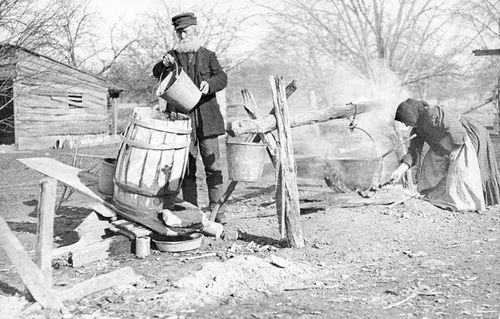Lye
Lye, also known as NaOH, sodium hydroxide, or caustic soda, is used in making soap, and also in biodiesel fuel production caustic potash, or potassium hydroxide (KOH), is also called lye and can be easily made at home. It can also be used in the production of biodiesel, although the recipe will have to be adjusted somewhat.
Basic Recipe
- from hard wood ash
- extraction with soft water; filter it at the same time
- boil off water
- voila ! The whitish powder is mostly potassium hydroxide
From the Household Cyclopedia (1881)
To make Saponaceous Lye for Washing: Boil together in a sufficient quantity of water, 1 gall. of good wood-ashes and 2 or 3 handfuls of fresh-burnt lime. Leave the lixivium at rest till the extraneous matters have been deposited at the bottom, or thrown to the surface to be skimmed off. Then draw off the pure lixivium, add to it oil, to about a thirtieth or fortieth part of its own quantity. The mixture will be a liquor white us milk, capable of frothing like soap-water, and in dilution with water perfectly fit to communicate sufficient whiteness to linen. This liquor may be prepared from wood-ashes of all sorts, and from rancid grease, oil or butter. It is therefore highly worthy the attention of the economist. When the ashes are suspected to be unusually deficient in alkali, a small addition of pulverized potash or soda may be made to the lixivium.
Uses
- to make biodiesel from various oils
- soapmaking
- in food, such as for lye rolls and pretzels
- key ingredient for geopolymers
- useful for breaking down cell walls as a preliminary to extracting phytochemicals from plants
- oven cleaner and drain opener
